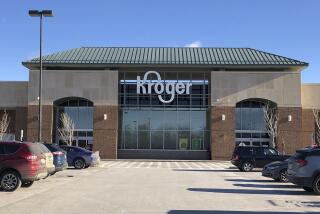Vons Tackles Major Task of Merging Two Cultures
- Share via
Back in January, a few weeks after Vons Cos. announced its plan to take over Safeway’s Southern California stores, some Safeway workers unpacking a case of catsup made an unusual discovery.
On one bottle, packed by a company that provided both grocery chains with private label products, Safeway’s Town House label was peeled back to reveal the Vons brand name. Workers took it as a favorable omen, and the bottle has since served as a reminder for the seven-person Vons transition team that has been working to ensure that the merger would proceed smoothly.
Last Monday, the team’s carefully devised game plan was implemented within minutes of the decision by the Federal Trade Commission to grant approval for the combination. The $408-million acquisition was completed, Vons crowed about the merger in radio ads as “the biggest event in Southern California supermarket history.” Employees in the 162 Safeway stores donned new Vons uniforms and started reducing prices on more than 13,000 Safeway items to bring them into line with Vons’ pricing structure.
In the next few weeks and months, more significant changes will take place as those stores are repainted and remodeled; Vons private label goods replace Safeway brands; computer systems are integrated; Safeway workers absorb changes in corporate culture, credit unions and seniority rankings; Safeway and Vons warehouses are reconfigured, and the exterior Safeway signs come down and are replaced by Vons signs (on a grand reopening day a few weeks hence that Vons insiders have dubbed V-Day and will be heavily promoted).
The task of integrating these two large companies, with combined revenues of about $5 billion, is formidable, Vons officials and outside experts agree. Key to ensuring success, they add, will be to keep nearly 11,000 Safeway employees and countless customers satisfied.
“It is merging two cultures--not only operating methods and techniques but also what might be called two sets of values,” said Roger E. Stangeland, chairman and chief executive of Vons. “The challenge is almost a behavioral science one.”
Added Norm McMillan, a Chicago consultant who advises Vons: “I have been very impressed with the difficulty of the task. Everybody thinks, ‘Oh, you just change the sign over the door,’ but it really isn’t that easy. There will probably be some mistakes, and they will learn as they go.”
No one knows that better than Gary Nelson, Vons executive vice president for corporate development and head of the transition team.
“Our challenge was to get our arms around the organization,” Nelson said Thursday in an interview at Vons’ El Monte offices, decked out with a congratulatory bouquet and beribboned champagne bottle. “We’re trying to weave Safeway into the fabric of Vons as soon as possible.”
The first challenge, Nelson said, was to understand Safeway’s culture and to communicate with Safeway employees exactly what was happening.
Nelson and Vons President William S. Davila met with as many managers as possible in the days after the agreement was announced in early December. In January, Nelson’s team moved into Safeway’s offices in Downey.
Careful About Promises
“We made a real effort to communicate,” Nelson said. “We said the bad news was that their company was being sold and that there would be changes, but that the good news was we’re a fine company, a growing company.
“We made sure we never made statements we couldn’t deliver on, which meant that we didn’t always say as much as people wanted to hear.”
From the beginning, Vons told the Safeway workers, many of whom were skeptical, that it intended to keep nearly all 11,000 employees. To date, only about 100 salaried personnel have been laid off, and they will be receiving severance benefits totaling “well into the seven figures,” Nelson said. (A small number of employees in stores that the government ordered sold will also be temporarily without jobs but will be on a priority rehiring list.)
In some cases, workers have more to be concerned about. Vons chose to retain several marginal Safeway stores but has “leveled with” employees that the stores face closure if they do not improve performance, Nelson said.
John C. Sperry, president of the United Food & Commercial Workers Local 324 in Buena Park, met with Vons a dozen times on behalf of Safeway workers to handle arrangements for seniority, benefits and other employee concerns. He said the two sides “were both looking for solutions to do what was right for the employees.”
At one point, some Safeway truck drivers came up with blue corduroy baseball-style caps inscribed with VONSWAY, a gesture that reassured Vons officials.
Employees were kept abreast of changes with half a dozen videotapes and a biweekly newsletter called Market to Market. The publication told of new requirements for uniforms, described Vons’ corporate philosophy and its various grocery formats and detailed developments as the merger wended its way through the regulatory process.
Decision Delayed
That process proved to be the biggest stumbling block, officials indicated. As of late Friday, Vons was still negotiating with the state attorney general’s office to avoid a lawsuit challenging the merger on the grounds that it would reduce competition. “Negotiations have progressed enough that we are hoping no lawsuit will be necessary,” said Michael J. Strumwasser, special assistant to California Atty. Gen. John K. Van de Kamp.
(Van de Kamp on Friday sought a temporary court order blocking another major supermarket merger--that of American Stores and Lucky Stores. U.S. District Judge David V. Kenyon delayed a decision until Tuesday so that he could study the case.)
For Safeway, which has been viewed as a laggard in this market, the shift in ownership promises a chance for rejuvenation, said David R. Willensky, a partner in the Los Angeles office of McKinsey & Co., a consulting firm.
“Vons is going to have to improve Safeway’s performance substantially just to break even,” he said, adding that “the Vons people . . . appear to have this very well thought out.”
Vons plans to spend more than $200 million on remodeling and upgrading Safeway stores over the next three years, Nelson said.
Some Safeway customers are bound to remain oblivious for awhile. Vons is continuing to advertise the stores separately until prices have been changed and Safeway stores stocked with Vons goods. Customers will be seeing a number of hand-lettered signs with such messages as “Make all checks payable to Vons.”
Vons must come to grips with one ironic factor, noted consultant McMillan. “(Safeway) had very quiescent stores,” he said. “Maybe that was an edge to a certain group of customers. They could walk the aisles without as many people in the stores.” Vons, on the other hand, acknowledges that it has a problem with crowded aisles and slow checkout lines, problems that it said it is addressing.
Safeway has some other things going for it, too, the Vons transition team found. Its bakery, on Boxford Avenue near Slauson Avenue in City of Commerce, will replace Vons’ smaller operation in El Monte.
And focus groups with employees prompted Vons to adopt another Safeway institution companywide, a company-supported employees association, founded in 1932, that plans social events. Beginning next year, Vons plans to found the Vons Employees Assn., with weekly dues of 25 cents per employee, the same fee that Safeway charged in 1932.
More to Read
Inside the business of entertainment
The Wide Shot brings you news, analysis and insights on everything from streaming wars to production — and what it all means for the future.
You may occasionally receive promotional content from the Los Angeles Times.











